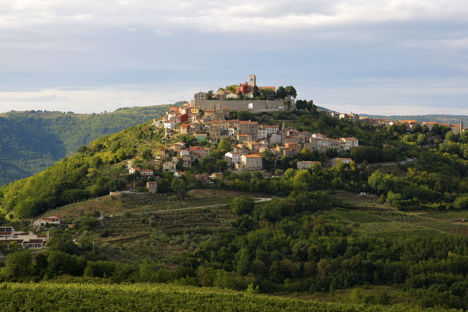
The Istrian larder: exceptional produce on Croatia's picturesque peninsula
In the secluded western Croatian peninsula of Istria, a glut of world-leading produce lies waiting to be discovered. Hosted by the Istria Tourist Board and Croatian National Tourist Board, Great British Chefs’ Chef Editor Mike Daw joined chef and writer Jordon Ezra-King for a gastronomic adventure.
Photo: Goran Sebelic
The Istrian larder: exceptional produce on Croatia's picturesque peninsula
In the secluded western Croatian peninsula of Istria, a glut of world-leading produce lies waiting to be discovered. Hosted by the Istria Tourist Board and Croatian National Tourist Board, Great British Chefs’ Chef Editor Mike Daw joined chef and writer Jordon Ezra-King for a gastronomic adventure.
Photo: Goran Sebelic
Istria, the verdant western peninsula of Croatia, presents itself as a fiercely independent state. The history and language lean Italian, while its more modern history speaks to Slavic and Croatian tradition; here in Istria the combination is unique, celebrated, and waiting to be discovered.
Inhabited for hundreds of thousands of years, the land yields ancient surprises. Boskarin cattle used for millennia by sporadic Istrian settlements still feature prominently in the Istrian diet, as does the plentiful bounty from the sea. Olive groves stretch for miles and Istrian Malvasia wine, first recorded in the 1800s but said to have been planted for centuries prior, adorn every restaurant and dining room table.
Beyond the peninsula’s rolling hills, white roads and stony hilltop villages – complete with towered churches – the Istrian larder is a thing of beauty and unexpected quality.
During a recent research trip in partnership with the Istrian Tourist Board and Croatian National Tourist Board, Jordon Ezra-King and Mike Daw uncovered the exceptional produce which sets the Istrian region apart. Here, we shine a spotlight on three of Istria’s most beautiful and important products.
Malvasia Istriana
For mile after mile, vines carrying the plentiful Istrian Malvasia grape emerge over the rolling hillocks, nestled between the frequent oak motts of the peninsula’s interior. This evokes the memory of a near-Tuscan landscape, but whereas the bold Italian grapes of Tuscany like sangiovese and vernaccia are expressed in wine with a warm tannic character, malvasia Istriana, most commonly expressed as a white wine, is dry, flinty and fresh.
The four soils of Istria - white, grey, black and red - each bring a particular defining feature to malvasia. Wines from vineyards that hug the cerulean Adriatic on Istria’s stony coastline have a drier minerality, indicative of the white and grey soils. The richer and fuller bodied expressions owe much to black and red soils found in the more mountainous interior: the fertile soil a result of rock runoff from the Ucka range.
In the last decade, the array of dry and richer whites has proved irresistible for winemakers, who’ve adopted ‘Méthode Champenoise’ (or Méthode traditionnelle) into their production, going beyond classic still white expressions of malvasia, to craft bright and immensely desirable sparkling wines.
One reclusive winemaker in the hills around Vrh, in the Buzet region, produces these fabulous expressions, but in tiny quantities, refusing to make more. He sells cases only to family friends, two or three very local restaurants, and those intrepid enough to seek him out, hiding in the hills. You might have had malvasia before, but you won’t have had it like this.
This lesser known, somewhat undiscovered quality speaks volumes when attentive and dedicated winemakers apply their craft to a grape often considered as one of the Mediterranean’s cheaper alternatives. The result is unexpected, elevated elegance.
Olive oil
Olive oil, as with so much produce from Istria, is as surprising as it is delicious. Surprising in quality, first and foremost, as the region is consistently ranked by Flos Olei (think the Michelin Guide for extra virgin olive oil) as the world's best for producing this liquid gold.
But also surprising is the number of producers that are opting to plant groves as opposed to vines. Of the more than 70 Croatian olive oils regularly featured in the Flos Olei list, Istrian producers make up more than 95 per cent of those listed. There’s clearly some magic in Istria.
It’s something understood by the multi-award-winning Chiavalon estate, who consistently rank with 95+ scores (out of 100) for their oils, and recently won the ‘Azienda Green’ (Green Estate) award for sustainable practices at the farm. Sandi and Tedi Chiavalon are third generation olive oil producers, starting out with their grandfather's grove of just 50 trees, which today are between 300 and 400 years old.
The story is familiar across Istria. This is a peninsula connected by land, by legacy and by craft. Across the region, countless artisans gently expand their operations as time goes by, bringing their families on board to continue these traditions, maintaining the very best standards of production and quality of produce all the while.
The Chiavalon estate now spans some 12,000 trees with a further 10,000 from local farms of the surrounding area contributing to the range of oils produced and with a metaphorical mantlepiece creaking with very real awards, their grandfather would doubtless be proud of the work the brothers have done since 1997.
Tasting the variety of peppery, citric, earthy and light olive oils which are made at Chiavalon, it’s no surprise that they perform so well on a global stage. Just another feather in the gastronomic cap of this fascinating, lesser-known region.
Truffles
The sprawling Motovun forest along the fertile Mirna valley in northern Istria engulfs the quiet, impossibly pretty hilltop towns of Golibici and Livad. It also hides treasure. Blooming, bulbous things, impossible to capture without the aid of well-trained dogs: truffles are rife in this part of Istria, and are among the world’s best.
Italy’s Alba may be known for its white truffle, the rarest and most expensive variety, but the Motovun forest is where one of the world's largest Tuber Magnatum Pico (weighing over 1.3 kilos) was discovered. The vast, unkept forest feels inadmissible without guidance: an impregnable wall of hazel, oak, ash and elm. It’s as if the Motovun knows what jewels are inside and is making every effort at security.
Fortunately, Nikola Tarandek has been ‘hunting’ (a word he resists as ‘foraging’ is probably closer, yet this he contests too as the dogs do the real work) in these hills for decades. ‘This would be impossible without them, 'Tarandek says, ‘even truffles that are not deep, you would never see them in the forest.’
The dogs work to cover as much ground as they can, bounding up barely walkable paths and jumping through narrow gaps in the thickets. Tarandek watches all from a thoughtful, observant distance, able to decipher the body language of a hound that has picked up the scent of a truffle.
Strong sniffing is the first indicator, before circling (snout down) on a sixpence. Then the gentle digging starts. These natural jewels sit hidden, obscured from the naked eye by inches, sometimes feet, of soil, and only detectable with a fully-trained helper (or two).
Tarandek’s only job really is to keep the dogs happy and working, ‘treats help, and sometimes giving them a truffle at home, too’ he chuckles.
Uncovering Istrian truffles is yet another example of how this lesser-known region reveals itself through world-leading gastronomic excellence.
There’s a quiet brilliance around Istria, a destination that until just a few years ago wasn’t on many radars. The history blends Italian and Slavic traditions via a culinary identity rooted in quality. Things are done slowly here: the olive groves might be 400 years old, the vines are ancient and the truffles expand silently, and unseen. Yet, taking time seems to be working, as the remarkable quality of produce and producers here consistently demonstrate, marking this once overlooked peninsula out as a gastronomic haven.

